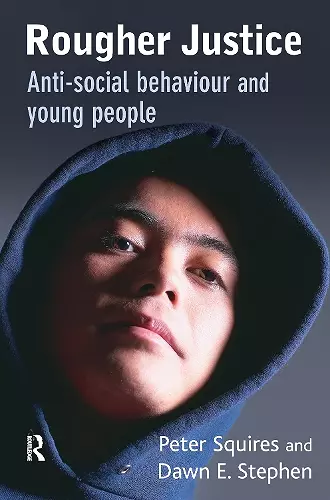Rougher Justice
Peter Squires author Dawn Stephen author
Format:Hardback
Publisher:Taylor & Francis Ltd
Published:5th Dec '16
Currently unavailable, and unfortunately no date known when it will be back
This hardback is available in another edition too:
- Paperback£39.99(9781843921110)

Anti-social behaviour has become a major political preoccupation of government and combating it is now a major plank of criminal justice policy. Yet anti-social behaviour as a concept has been little studied, and the notion has often been accepted uncritically. This book aims to meet this need, providing a critique of the government's use of the concept of anti-social behaviour and of youth justice strategy more generally. Rougher Justice foregrounds the perspectives and experiences of young people themselves. It draws upon recent developments within the field of cultural criminology to provide an alternative interpretation of the construction of 'youthful criminal careers'. It is underpinned by research in three separate areas which focus on the new youth justice, youthful criminal careers, and anti-social behaviour and acceptable behaviour enforcement. Central to the book is an ambition to understand youthful delinquency from the inside and to recover what is lost in much of New Labour's youth justice strategy --and the methods adopted by the Youth Justice Board to evaluate this strategy, that is to say a situated and interpretive understanding of youthful delinquency drawn from the perspective of and in the voices of young people themselves.
This an impressive treatise which pulls together and adds to papers that the authors have presented in journals and conferences since 2001. It is, I think, the first to trace the ‘irresistible rise’ of anti-social behaviour (ASB) and explores how this ill-defined phenomenon has come to dominate the current politicization of young people’s behaviour. We are offered a critique of the positivist criminology that has so easily lent itself to the managerialist style of New Labour as it courts ‘the responsible, respectable . . . decent law abiding majority . . .’ (Tony Blair’s speech July 2004, quoted on p. 24). The final chapters, drawing on work with young people involved with vehicle crime and Acceptable Behaviour Contracts, is a call for the resurgence of interactionist perspectives to explore the actual experience of the key players in the real world. This reviewer, whose varied involvement with these young people has spanned the time covered by the main sources quoted, enjoyed recognizing where theory and practice have been in or out of step over the last fifty years.The authors demonstrate how ASB has become ‘a precursor to crime and a criminal career or a fellow traveller of crime . . . . Or, in a different sense, ASB represents an enforcement opportunity’ (p. 73) ‘so useful—as a sign, a symptom, a risk predictor, a popular and universal complaint, an enforcement point, a flexible and selective rationale for intervention or inaction’ (p. 66). The authors survey ASB against the anti-social environments in which we should not be surprised to find young people making anti-social choices. They use Cohen’s (1985) eight-point approach to review links between ASB, the new youth justice and the dispersal of discipline as seen in community safety policy and practice. Emphasis is given to the familiar process by which alternatives become absorbed in the mainstream while new ideas are eroded by the continuance of old structures. Slowly but surely, the net of the criminal justice system has been widened and the entire population is both subject to increased surveillance and, through concepts of contract, increasingly drawn into acting as control agents. New Labour’s failure to seriously address the neglected and deprived people in our society is challenged. I anticipate that the Government’s response would be heavy investment in the very young and primary education—a policy which leaves Labour to target ‘terrible teenagers’ as collateral damage in a bid to prove its ‘middle England’ image. This book expertly covers responses to youth behaviour from Paterson, who established the Borstal Service (in which I worked) through Diversion (through which I was involved in championing Intermediate Treatment) to the wide scope of the UK’s Youth Justice Board (on which I am a volunteer). I am certain that in the early 1970s, we were well aware of the dangers of ‘net widening’ but, then, we did have good alternative community resources to divert to. These, it seems, have either disappeared or been brought into the youth justice system itself, presumably because that is where the Government has chosen to direct the money. The style of this book is decidedly academic and detailed, sometimes bordering on the obsessive, but there is occasional humour. I would not envy the civil servant who writes the one-page briefing paper which would persuade his master to change direction. For example, ‘The hegemonic influence of positive criminology within contemporary managerialist agendas is subsuming alternative ways of seeing, if not also stifling contemporary criminological imagination in its wake; in many ways, contemporary mainstream criminology is at risk of being reduced to the status of mere handmaiden to political paymasters’(p. 155). Passion comes in the final appeal: ‘If we as criminologists continue to nourish, rather than problematize, the ever-consolidating institutionalized mistrust of marginalized youth as effected in and through anti-social behaviour discourses and practices it suggests we have learnt nothing from Schur’s reconsideration of delinquency’ (p. 185). This excellent book hits all the marks, although it is disappointing to see so little reference to alcohol and drugs, which form such a constant factor in the lives of many of these young people. This book is essential reading and I, for one, hope that it marks a turning point in our approach to young people. Reference Cohen, S. (1985) Visions of Social Control, Cambridge, Polity Press. Malcolm Jordan Volunteer with Youth Offending Panels, Committee member for the General Social Care Council, and Lay Associate of the Healthcare Commission
ISBN: 9781138176409
Dimensions: unknown
Weight: 453g
248 pages